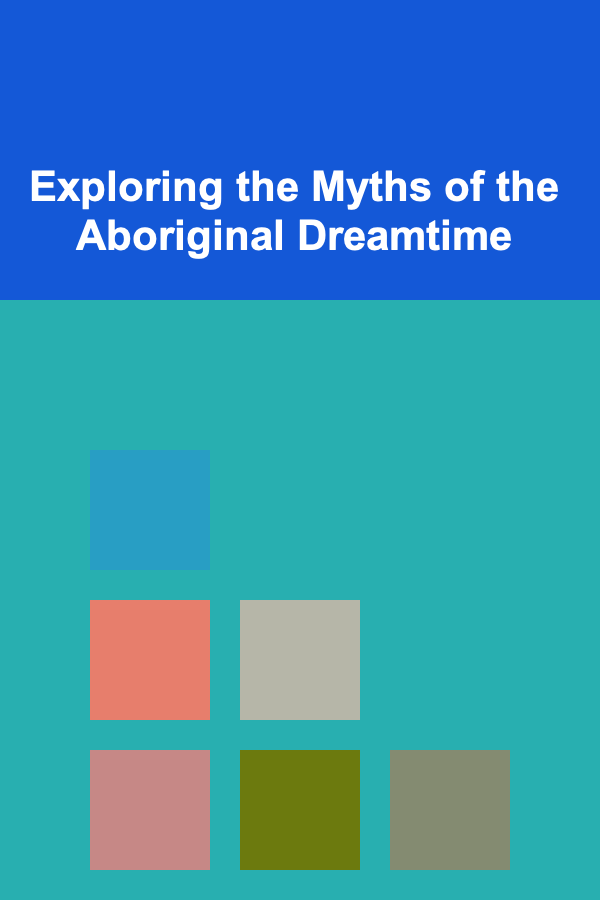
Exploring the Myths of the Aboriginal Dreamtime
ebook include PDF & Audio bundle (Micro Guide)
$12.99$10.99
Limited Time Offer! Order within the next:

The Aboriginal Dreamtime, also known by various names across different language groups, is far more than a collection of myths and legends. It is the foundational worldview of Aboriginal Australians, encompassing their creation stories, their laws, their social structures, and their connection to the land. Exploring the Dreamtime requires a respectful and nuanced approach, acknowledging its deep spiritual significance and its ongoing relevance to contemporary Aboriginal communities.
Understanding the Dreamtime: Key Concepts
Before embarking on any exploration of Dreamtime stories, it's crucial to understand some fundamental concepts. Misunderstandings and misinterpretations are common, often stemming from a Western worldview that clashes with the Aboriginal understanding of time, space, and causality.
What is the Dreamtime?
The term "Dreamtime," popularized in the English language, is a somewhat inadequate translation of complex concepts. A more accurate understanding is that it represents a realm where the ancestral beings created the landscape, the animals, the plants, and the people. These beings, often referred to as Ancestral Spirits or Creation Ancestors, traveled across the land, shaping it and imbuing it with their essence. This is not simply a past event; the Dreamtime is a continuous, living reality that exists alongside the physical world. It is accessed through ceremony, art, storytelling, and connection to the land.
Each Aboriginal group has its own specific Dreamtime stories, relating to their own ancestral lands and the beings that shaped them. These stories are deeply localized, meaning that a story told in one area may have significant variations in another, reflecting the unique features of the landscape and the experiences of the people who live there.
The Eternal Now: Time in the Dreamtime
Unlike the linear concept of time prevalent in Western cultures, the Dreamtime operates on a cyclical and interconnected understanding of time. The past, present, and future are not distinct but are interwoven and constantly influencing each other. The actions of the Ancestral Spirits in the Dreamtime continue to resonate in the present, shaping the landscape, the laws, and the social structures of Aboriginal communities. The past is not simply a historical event but a living presence that informs and guides the present.
The Land as a Living Entity
The land is not simply a resource to be exploited but a living entity that is deeply connected to the Dreamtime. Every feature of the landscape -- a rock formation, a waterhole, a tree -- has a story associated with it, linking it to the actions of the Ancestral Spirits. Aboriginal people have a profound responsibility to care for the land, recognizing that their well-being is inextricably linked to its health. This custodianship is not merely environmental; it's a spiritual and cultural obligation passed down through generations.
The Importance of Storytelling
Dreamtime stories are not just entertaining narratives; they are the primary means of transmitting knowledge, laws, and cultural values. They are often told through song, dance, and art, making them accessible to all members of the community, including children. These stories are carefully guarded and passed down through specific family lines, ensuring their accuracy and integrity. The act of storytelling itself is a sacred practice, connecting individuals to their ancestors and to the land.
Approaches to Exploring the Dreamtime
Exploring the Dreamtime requires a commitment to respect, cultural sensitivity, and a willingness to learn from Aboriginal people themselves. It is not something to be approached lightly or with the intention of extracting information for personal gain.
Listen to Aboriginal Voices
The most important aspect of exploring the Dreamtime is to listen to Aboriginal people. Seek out opportunities to hear their stories directly, either through personal interactions, public events, or reputable Aboriginal-owned and operated tourism companies. Be mindful that some stories are considered sacred and may not be shared with outsiders. Always ask for permission before recording or sharing any information you receive.
Engage with Aboriginal-Owned Tourism
Participating in Aboriginal-owned tourism experiences offers a valuable opportunity to learn about the Dreamtime from Aboriginal guides and cultural custodians. These tours are often designed to be culturally sensitive and respectful, providing visitors with a deeper understanding of the land and its spiritual significance. By supporting these businesses, you are contributing to the economic empowerment of Aboriginal communities and helping to preserve their cultural heritage.
Visit Cultural Centres and Museums
Many cultural centers and museums across Australia showcase Aboriginal art, artifacts, and stories. These institutions often work closely with Aboriginal communities to ensure that the information presented is accurate and respectful. However, be critical of the narratives presented and consider the perspectives of Aboriginal people themselves. Look for museums that are actively involved in repatriation efforts and that prioritize Aboriginal voices.
Read Aboriginal Literature
There is a growing body of literature written by Aboriginal authors that provides valuable insights into the Dreamtime and Aboriginal culture. Authors like Alexis Wright, Bruce Pascoe, and Sally Morgan offer powerful perspectives on the ongoing impacts of colonization and the resilience of Aboriginal culture. Reading their work can help to broaden your understanding and challenge your own assumptions.
Study Aboriginal Art
Aboriginal art is deeply connected to the Dreamtime. Dot paintings, rock art, and bark paintings often depict Dreamtime stories and the actions of the Ancestral Spirits. Learning about the symbolism and iconography used in Aboriginal art can provide a deeper understanding of the stories being told. Be aware that some art is considered sacred and may not be appropriate to reproduce or display without permission.
Respect Protocols and Permissions
When visiting Aboriginal communities or sacred sites, it is essential to respect local protocols and permissions. Many areas require permits to visit, and it is important to follow the instructions of local elders and custodians. Avoid taking photographs or videos without permission, and be mindful of your behavior and interactions with Aboriginal people. Remember that you are a guest on their land and should act accordingly.
Be Aware of Appropriation
Cultural appropriation is a serious issue, and it is important to be aware of the potential harm it can cause. Avoid using Aboriginal symbols, imagery, or stories without permission, and do not attempt to replicate Aboriginal art or practices without proper training and guidance. Instead, focus on learning about and appreciating Aboriginal culture in a respectful and authentic way.
Common Misconceptions and Pitfalls
Exploring the Dreamtime can be challenging, and it is easy to fall into common misconceptions and pitfalls. Being aware of these can help you to avoid making mistakes and to approach your exploration with greater sensitivity and understanding.
The Dreamtime is Not "Just Myths"
The Dreamtime is often dismissed as "just myths" or "fairy tales," but this is a gross misunderstanding of its significance. The Dreamtime is a complex and sophisticated worldview that provides a framework for understanding the world and one's place within it. It is not simply a collection of stories but a living tradition that continues to shape Aboriginal culture and identity.
Generalizing About Aboriginal Cultures
It is important to remember that Aboriginal Australia is not a monolithic entity. There are hundreds of different language groups and cultural groups, each with its own unique Dreamtime stories, customs, and traditions. Avoid making generalizations about "Aboriginal culture" and instead focus on learning about the specific cultures and communities that you are engaging with.
Romanticizing or Idealizing Aboriginal Life
It is tempting to romanticize or idealize Aboriginal life, but this can be just as damaging as dismissing it. Aboriginal communities face significant challenges, including poverty, discrimination, and the ongoing impacts of colonization. Acknowledging these challenges is essential for understanding the realities of contemporary Aboriginal life.
Assuming the Dreamtime is a Thing of the Past
The Dreamtime is not a thing of the past; it is a living reality that continues to be relevant to contemporary Aboriginal communities. The stories and traditions of the Dreamtime are passed down through generations, shaping cultural identity and providing a framework for understanding the world. Avoid assuming that Aboriginal culture is static or unchanging.
Expecting All Aboriginal People to Be Experts on the Dreamtime
Not all Aboriginal people are experts on the Dreamtime. Knowledge of specific stories and traditions is often held by specific individuals or families, and it is not appropriate to expect every Aboriginal person to be able to answer all of your questions. Be respectful of their knowledge and expertise, and do not pressure them to share information that they are not comfortable sharing.
The Ongoing Significance of the Dreamtime
The Dreamtime is not just a relic of the past; it continues to play a vital role in the lives of contemporary Aboriginal Australians. It provides a foundation for cultural identity, a framework for understanding the world, and a source of resilience in the face of ongoing challenges.
Cultural Identity and Connection to the Land
The Dreamtime provides a strong sense of cultural identity and connection to the land. It connects individuals to their ancestors, their history, and their place in the world. This connection is particularly important in the context of colonization and the ongoing struggle for Aboriginal rights.
Law and Social Order
The Dreamtime provides the foundation for Aboriginal law and social order. The stories and traditions of the Dreamtime outline the rules and responsibilities that govern social interactions and relationships. These laws are often based on principles of reciprocity, respect, and sustainability.
Healing and Reconciliation
The Dreamtime can play a vital role in healing and reconciliation. By understanding the history and culture of Aboriginal people, non-Aboriginal Australians can begin to address the injustices of the past and work towards a more just and equitable future. The Dreamtime can provide a framework for understanding the ongoing impacts of colonization and for promoting healing and reconciliation between Aboriginal and non-Aboriginal Australians.
Environmental Stewardship
The Dreamtime provides a framework for environmental stewardship. The stories and traditions of the Dreamtime emphasize the importance of caring for the land and living in harmony with nature. This perspective is particularly relevant in the context of climate change and the need for sustainable practices.
Conclusion
Exploring the myths of the Aboriginal Dreamtime is a journey of discovery that requires respect, sensitivity, and a willingness to learn. It is a profound exploration into a worldview that prioritizes connection to land, the cyclical nature of time, and the importance of storytelling. By listening to Aboriginal voices, engaging with Aboriginal-owned tourism, and respecting cultural protocols, we can gain a deeper understanding of the Dreamtime and its ongoing significance to contemporary Aboriginal communities. This understanding is essential for building a more just and equitable future for all Australians.
Remember, this exploration is not about appropriating or extracting, but about listening, learning, and respecting the wisdom and resilience of Aboriginal cultures. It is about recognizing the deep spiritual connection that Aboriginal people have to their land and their ongoing struggle to protect their culture and their rights.
The Dreamtime is a living tapestry woven through generations, a vibrant and enduring testament to the strength and beauty of Aboriginal culture. Approaching it with humility and a genuine desire to understand is the first step towards a more meaningful connection to the land and its people.
Disclaimer: This article provides a general overview of the Aboriginal Dreamtime. It is important to remember that Aboriginal Australia is incredibly diverse, and each language group and cultural group has its own unique stories and traditions. This article is not intended to be a comprehensive guide, and further research and engagement with Aboriginal communities are encouraged.

How to Add a Second Story to Your Home During Renovation
Read More
How to Plan a Group-Friendly Dinner Party at Home
Read More
How to Plan for a Comfortable Early Retirement
Read More
How to Properly Maintain Your Refrigerator for Longevity
Read More
Unlocking Insights with Data Science: A Comprehensive Guide for Professionals
Read More
How to Combine Yin Yoga and Meditation for Relaxation
Read MoreOther Products

How to Add a Second Story to Your Home During Renovation
Read More
How to Plan a Group-Friendly Dinner Party at Home
Read More
How to Plan for a Comfortable Early Retirement
Read More
How to Properly Maintain Your Refrigerator for Longevity
Read More
Unlocking Insights with Data Science: A Comprehensive Guide for Professionals
Read More